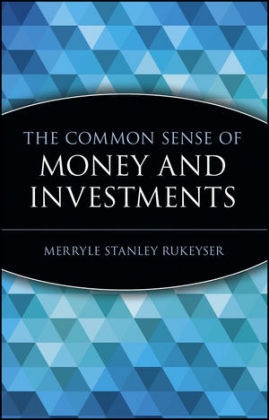Read more
Informationen zum Autor MERRYLE STANLEY RUKEYSER was one of the most respected market observers in America for more than six decades. His rise to prominence as a leading financial journalist began in 1920, when, at the age of 23, he was made Financial Editor of the New York Tribune. After a stint at the New York Evening Journal, he spent more than three decades as a nationally syndicated newspaper columnist. He is perhaps best remembered by today's investors for his regular guest appearances on "Wall Street Week With Louis Rukeyser" during the 1980s. Klappentext "In a world where ridiculously hyped tomes promising instant financial euphoria for ordinary citizens now vie with counsel on health and sex in every bookstore, old-fashioned common sense still takes the prize. Most of the would-be gurus, not to mention their customers, would have been better off to read this one first." -From the Foreword by Louis Rukeyser Books of investment advice have been around forever, or at least for as long as the general public has been playing the markets-which, to most people's minds, is practically forever. So it will come as a surprise to many encountering The Common Sense of Money and Investments for the first time that this classic, published in 1924, was one of the first of its kind. Perhaps even more surprising is how remarkably well it has stood the test of time. There have been monumental changes in the financial markets over the past seven decades, yet the essentials remain the same: people are still people, with all their foibles, and capital still obeys its ineluctable principles. And you will find as you read through this book that its common sense advice on everything from investor psychology to picking stocks rings as true today as it did three-quarters of a century ago. Zusammenfassung Bücher zum Thema Investment gibt es viele, doch nur wenige sind so zeitlos gültig wie dieses. In seinem charmanten, direkten Stil beweist Rukeyser, daß die besten Ratschläge zur Geldanlage tatsächlich zeitlos sind. Er liefert faszinierende Einblicke in das Anlagengeschäft unmittelbar nach dem Ersten Weltkrieg und vor dem großen Börsenkrach. Ein sehr detaillierter und nützlicher Leitfaden. (04/99) Inhaltsverzeichnis WHY INVEST?-A COMMON SENSE PROBLEM. A Common Sense View of Money. When to Enjoy the Fruits of Your Labor. Legitimate Objectives of Thrift. Outlets for Surplus Funds. The Mind of the Small Inventor. The Radical and His Bonds. DONT'S FOR INVESTORS-AND A FEW AFFIRMATIONS. Tests of a Safe Investment. Why Not Get Rich Quick? Investing Without Red Tape. Investment Programs for Rich and Poor. When to Switch from Stocks to Bonds. How to Select an Honest Broker. How to Detect a Security Charlatan. Bucket Shops-and How to Keep Out of Them. High Finance-and the Public Good. Has the Day of Opportunities Passed? A Formula for Effective Thrift. FINANCIAL KNOWLEDGE AS A TOOL. Secrets of the Financial Page. Some Fallacies of the Investment Column. The Story Behind the Figures in a Financial Report. Soothsayers in Wall Street. Half Truths About Wall Street Affairs. Big Business Flirts with Virtue. Lessons From the Lives of Field Marshals of Industry. The Customer Buys the Plant. Banks for the Impecunious. "One Dollar Down And-." Avoiding Bankruptcy in the Pantry. Picking Your Employer and Your Job. How to Turn Old Age from a Defeat Into a Triumph. On the Alleged Root of All Evil. Books as Stepping Stones to Business Success. Appendix. Bibliography. Glossary. Bond Yield Formula. Bond Interes...

